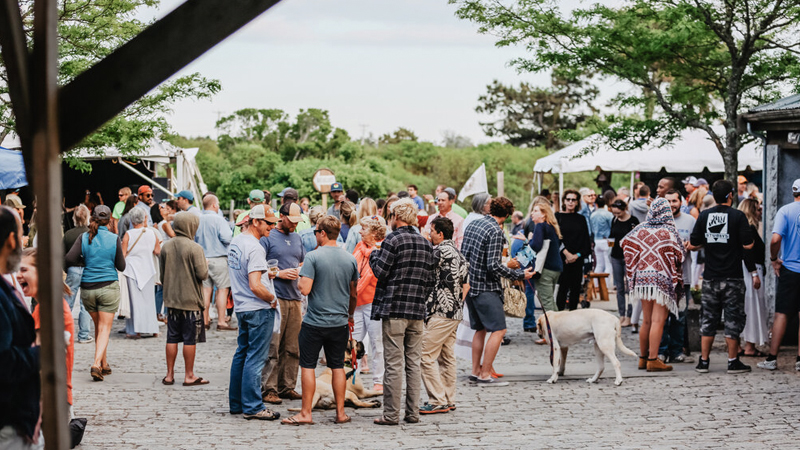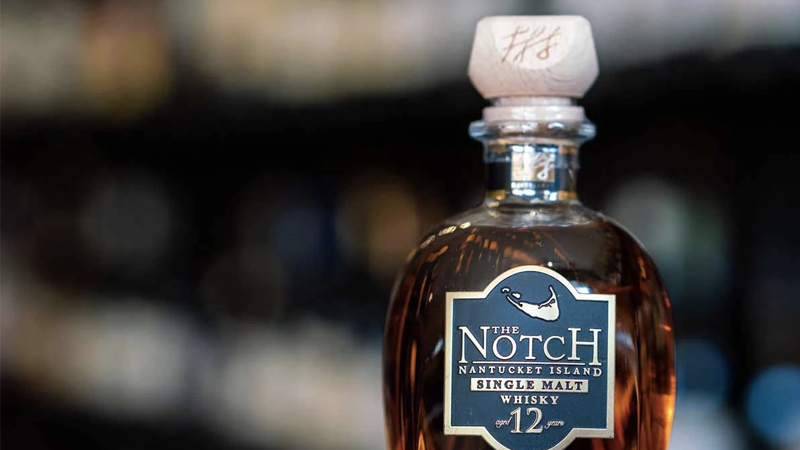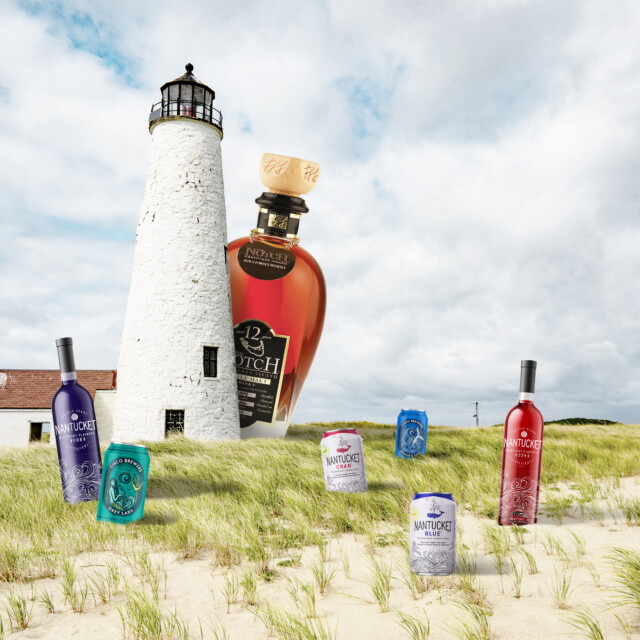A Gen-Zer’s recent viral TikTok, just eight seconds long, scans the crowd at an outdoor bar. Women in Lilly Pulitzer dresses and pearls. Men in Vineyard Vines quarter-zips and dock shorts. The only thing whiter than the clothes are the people. “The richest place I’ve ever been,” captions the TikTok, “is a Saturday at Cisco Brewers on Nantucket.”
Started in 1995, Cisco Brewers was spawned from the tony Massachusetts island’s first winery, Nantucket Vineyard, opened in 1981 by Dean and Melissa Long. Located in the Atlantic Ocean some 26 miles south of Cape Cod, they were unable to grow grapes and started importing them instead. In May 1992, another couple, Randy and Wendy Hudson, moved into a loft over the winery and began assisting with winery operations. At the time, Randy was a dreadlocked breadmaker who had begun playing around with homebrewing, going so far as to mill his own grain using a pasta roller.
By 1995, the two couples had branched out to open the island’s first brewery, Cisco Brewers, brewing the beer outdoors and then selling it. It was a humble operation, so small they called it a nano-brewery. “[I] remember when it was only a counter in a barn near Bartlett Farm,” one commenter reminisces on that aforementioned TikTok.
Over the last three decades you’ve surely encountered Cisco’s Grey Lady Wheat Ale or Whale’s Tale Pale Ale, both of which have long had distribution throughout New England and the rest of the Northeast. Cisco, in fact, would become successful enough that, by 2018, the Craft Brew Alliance (CBA), a publicly traded company from Portland, Ore., spent around $23 million to acquire it. Then in 2020, Anheuser-Busch InBev spent $220 million to fully acquire the CBA, effectively turning this tiny island craft brewery into “Big Beer.”
Today the brewery has four locations in addition to Nantucket: the Boston Seaport; New Bedford, Mass.; Portsmouth, N.H.; and Stamford, Conn. And, if you visit any of these locations, or closely rewatch that eight-second TikTok, you’ll notice most of these island elites are crushing cans of beer or drinking plastic cups of pink vodka cocktails.
But, the funny thing is: The best single malt whisky in America is also being made at Cisco Brewers in Nantucket.
Be Damned the Cost
“We’re not very good at leveraging our accolades,” says Randy Hudson.
Earlier this year his 12-year-old expression had been named World’s Best Small Batch Single Malt Whisky. A few weeks before that, it won best American single malt at the prestigious San Francisco World Spirits Competition. These weren’t necessarily shockers — the whisky has pretty much cleaned up on the awards circuit over the last decade-plus.
And, yet, most people have never heard of it. In fact, even as someone who talks daily with bartenders, bar owners, whiskey connoisseurs and collectors, as well as fellow spirits scribes, I only know a couple people who have ever even tasted The Notch (i.e. Nantucket scotch) single malt.
Hudson had been and still was the original mash man for Cisco Brewers at the turn of the century when he and Dean Long started focusing on distilling whisky as well. (They had already been distilling fortified wine at the vineyard.) But Hudson’s body was starting to break down from the physicality of brewery work and, at the same time, he seemed to be developing some gluten sensitivities to beer.
Founded in 1997 and named after its water source, Triple Eight Distillery would be the seventh — that’s right, the seventh — craft distillery in America. You had Germain-Robin, St. George Spirits, and Charbay, all founded in California between 1981 and 1983, but not much more than that. It was simply too expensive, too challenging, and way too time-consuming for most would-be beverage entrepreneurs.
“After seeing how the craft movement developed in beer, though,” says Hudson, “we knew we were going to be at the leading edge of a wave of change to come in distilling too.”

They had no choice but to make single malt whisky; barley was the only grain their brewing equipment could process. Making bourbon or rye whiskey was out of the question as a corn or rye-heavy mash would seemingly turn into “concrete” in the mash tun and potentially wreck their waste water.
It wasn’t any barley, however. Long and Hudson opted for Maris Otter from the U.K., an heirloom variety of malted barley commonly used for beers, but not one typically used in single malt. It was already the base malt for Whale’s Tale Pale Ale.
“I just loved the flavor and figured it would make good whisky … or at least unique whisky,” says Hudson, who would ferment it with a mix of brewer’s and distiller’s yeast, then distill it on an Arnold Holstein copper still. (In 2008, Long returned his focus to winemaking and Hudson took over as lead distiller. Today Hudson is head blender while Bryan Jennings is now head distiller.)
“I’ve also always said: Be damned the cost,” claims Hudson. “I pay for good ingredients and I try to make things as best I can.”
That ethos would be critical to getting The Notch to where it is today. If the numerous craft whisky makers that would pop up in the late-aughts and early-2010s would opt for aging in teeny tiny barrels that created way too much wood contact, Hudson would use standard 53-gallon ex-bourbon barrels from day one. Today, sherry casks and wine barrels from Nantucket Vineyard are also employed.
Likewise, if those numerous craft whisky makers would impatiently release whiskies with an age measured in months, not years, Hudson would take until 2008 (08/08/08, in fact) to release an eight-barrel batch of his first product, The Notch 8 Year Old.
The cost? $888.
The Incredulity
“Nantucket is very expensive [with] hotels, restaurants, getting there in the first place, and oriented around expensive activities like sailing,” says Adam Polonski, co-owner of Lost Lantern, an independent bottler of American craft whiskey. “Cisco Brewers is really the only place we found on the island that felt accessible and affordable to anyone.”
What isn’t really affordable to most, however, is The Notch. Sure, it’s no longer $888, but the 12 Year Old and 15 Year Old cost $350 and $500, respectively, at the brewery gift shop. (A world-class Scottish single malt of a comparable age might retail for $75 to $150.)
Polonski and his wife/co-owner, Nora Ganley-Roper, loved The Notch so much they had even considered bottling a single cask of it, but simply couldn’t afford the elevated expense compared to other craft single malt in America.
That’s fine with Hudson, who constantly hears the grumblings about his jaw-dropping prices.
“I don’t think there’s a lot of hate. But there is incredulity. People make fun of me. And I totally get it,” says Hudson. “We’re not making commodity whiskey. And I don’t want to run myself into the ground, or our staff, for just a couple bucks. We want people to appreciate what we’re doing.”
The problem, of course, is it’s hard to appreciate it if you need to travel by plane or ferry to a ritzy island you might not even be able to afford to spend the night on, fight through those Lilly Pulitzer and Vineyard Vines-clad crowds, and then drop several hundred bucks on a bottle.
Yes, you can get neat pours of it at those wild Cisco Saturdays — to the tune of $30 an ounce — but most customers would seemingly rather get drunk on cocktails made from Triple Eight’s popular Blueberry or Cranberry Vodkas instead. (“It’s why I don’t hang out there on Saturday,” jokes Hudson.)
Over the last decade, bottles have occasionally made it into distribution in the Boston area, Connecticut, Rhode Island, and even New York City, where prices soar over $700, but Triple Eight simply doesn’t produce enough of it for that to always be the case.
Only 150 barrels of The Notch are filled per year, then aged 8, 12, or even 15 years, meaning perhaps only a few thousand bottles are even available to put on shelves every year. That’s not to mention all the supply chain issues that have affected Triple Eight of late, like a lack of corks that meant Hudson couldn’t bottle a tank of 8 year old on time this year. While another thorn in his side has been that his gorgeous, double-curved Italian-made bottles necessitate metal labels as paper won’t conform to the unique shape.
The concerted effort it takes simply to get The Notch to market, and then for an average customer to score some, would seemingly echo a motto that once appeared on the original Cisco Brewers T-shirt: “Nice beer, if you can get it.”
World-class whiskey, if you can get it.
Uniquely Nantucket
So, come on, is The Notch really that great? And, if so, why?
Well, it’s by leaps and bounds the oldest single malt in America. The only other single malt in the States that has even cleared the decade mark is Stranahan’s Mountain Angel, first released to much ballyhoo in 2020. Hudson, meanwhile, tells me he currently has barrels of 17-year-old maturate in his warehouse that he might let age all the way to 20 years.

“Really it’s a grand experiment: What’s the sweet spot, what’s the ideal age for this environment?” he asks. It’s that unique environment that Hudson believes is truly the secret sauce for why The Notch is so stellar. “I always try to give as much credit to Nantucket as I can for what makes our whisky good,” he says.
As one of the few island whisky makers in America, he compares Nantucket’s maritime climate to that of the western isles of Scotland where whiskies like Talisker are made. The island is cool and moist in the winter; hot and humid in the summer. The ocean breeze is always blowing through Triple Eight’s ventilated warehouses. And yet, you don’t get a briny note from The Notch like you might from Talisker. (Hudson reveals he does have some soon-to-be-released peated single malt in the works, however.)
Instead, it offers a ton of dried fruit on the nose before transitioning into a palate that balances sweeter notes of vanilla, caramel, and stone fruit with spiciness and a bit of smoke.
“Almost none of the buyers are people that live here,” says Hudson. “But I don’t know that the buyers are collectors per se. Quite a number of people want to have a special thing to commemorate their trip to Nantucket.”
American single malt in general has been getting more and more press coverage of late, something that was greatly bolstered by the TTB announcing an amendment to federal law 27 CFR part 5. It will finally include “American Single Malt Whiskey” as distinct and worthy of its own official standards of identity — that should become officially codified into U.S. law as of Sept. 27.
Could this be the push that finally puts The Notch on every American whisky lover’s radar?
Perhaps not.
Because Hudson isn’t even sure if this curious whisky he makes would still be considered single malt by these new standards. He has long distilled to whatever proof he feels tastes best. Sometimes that’s 155 proof, other times it’s as high as 165, which would be 5 points over the newly accepted limit. This new make goes into the barrel at 110 proof and during maturation might reach anywhere from 115 to 130 proof depending at what height it’s located in the rickhouse.
“By the new single malt standards, it might be problematic,” says Hudson. “What I don’t think is going to be a problem is that it will still be delicious.”
This story is a part of VP Pro, our free platform and newsletter for drinks industry professionals, covering wine, beer, liquor, and beyond. Sign up for VP Pro now!
